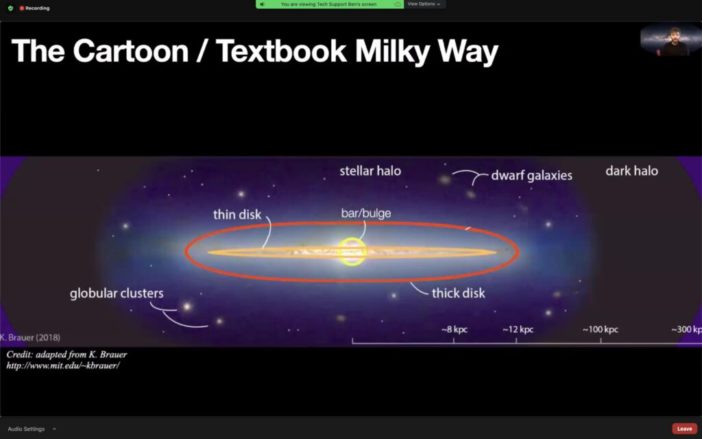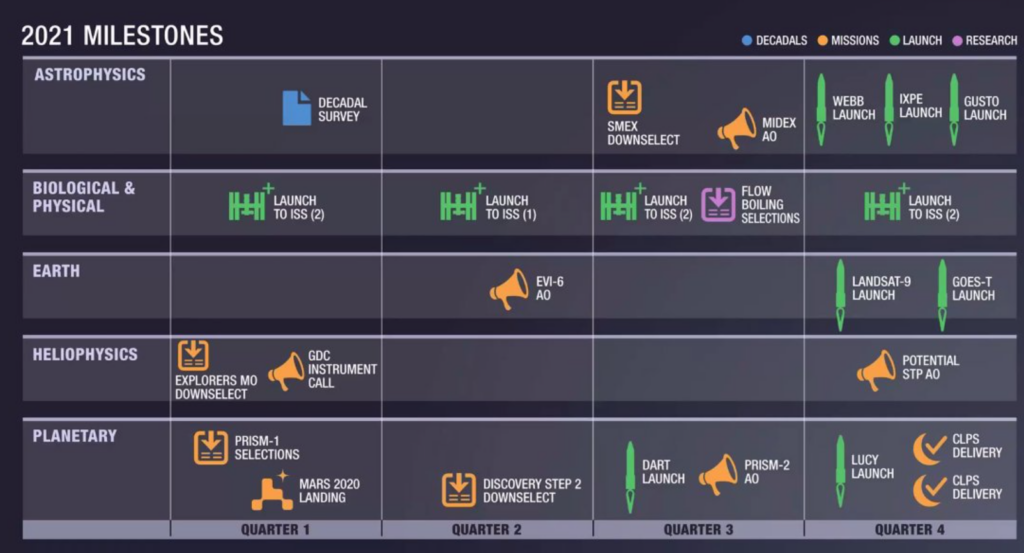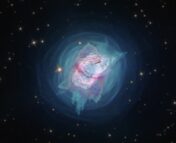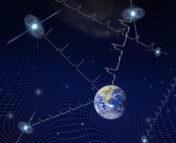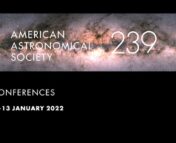Welcome to the virtual winter American Astronomical Society (AAS) meeting! Astrobites is attending the conference as usual, and we will report highlights from each day here. If you’d like to see more timely updates during the day, we encourage you to search the #aas237 hashtag on twitter. We’ll be posting once a day during the meeting, so be sure to visit the site often to catch all the news!

Plenary: Prize Presentations (by Abby Waggoner)
Day two of AAS 237 began with a brief overview of outstanding astronomers and the awards they received for their contribution to the field. All of the awardees are listed in this twitter thread, along with a description of the awardees’ accomplishments. Awards ranged across all fields of astronomy, including instrumentation, theory, education, writing, and more. Congratulations to all of the awardees!
Live-tweeting of the session by Abby Waggoner
Plenary: A New Era for Galactic Dynamics in the Milky Way (by Briley Lewis)
This morning’s first plenary was from Adrian Price-Whelan (Flatiron Institute), astronomer and astropy developer. He opened with a message that likely resonated with many of us, acknowledging how difficult the past year has been and how hard it is to work and be productive. “It’s okay if you’re unproductive, it’s okay if you’re struggling for motivation, it’s okay if you need to prioritize yourself or your family.”
The science part of this talk focused on galactic dynamics in the Milky Way. With all the surveys of Milky Way stars from the past few decades, we have lots of data to work with. Importantly, these surveys released their data publicly and spanned many modes of observation: photometry and time-domain imaging (2MASS, SDSS, GALEX), astrometry (Gaia), and spectroscopy (APOGEE, GALAH). Gaia is of particular importance, since it has added extremely precise parallaxes and proper motions for many stars in our galaxy. With all these data we can figure out stellar parameters, elemental abundances, kinematics, and more.
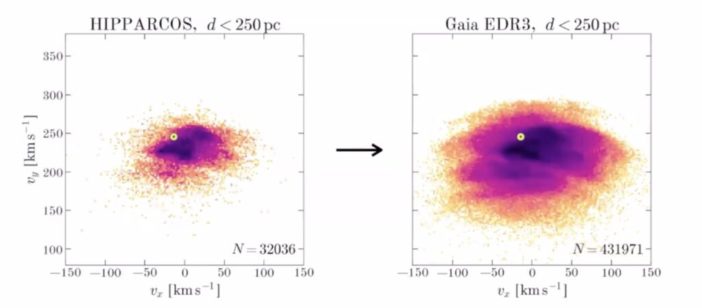
This plot from Price-Whelan’s talk shows the drastic increase in the number of stars with velocity measurements between the Hipparcos mission and the new Gaia mission.
For many years, studies of the Milky Way relied on “first order” models — smooth, simplified descriptions of the galaxy. Price-Whelan showed the classic “cartoon/textbook Milky Way” with a central bar, thin disk, thick disk, halo, and dark matter halo. We already know our galaxy also has sub-galaxies (like the Large and Small Magellanic Clouds, a.k.a. LMC/SMC) and dark matter subhalos.
The velocity of the Sun in the galaxy and our distance to the galactic center are well defined, and we have a good “big idea” picture of the galaxy’s overall density, rotation curve, and velocity dispersion in the halo. But with all these new data, like what we’re getting from Gaia, those first order models just can’t keep up with the precision. Price-Whelan is interested in looking at where we see deviations in the precise data from those first order models, to investigate the Milky Way’s structure in finer detail.
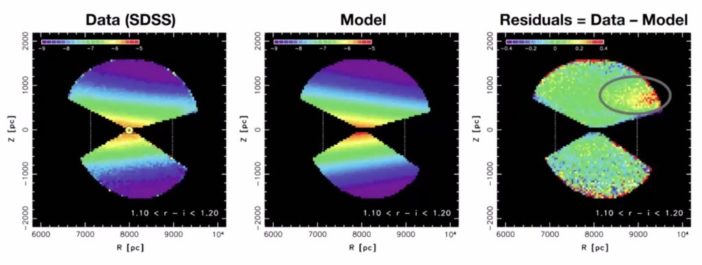
This plot from Price-Whelan’s talk shows observed data from SDSS and a corresponding smooth model. The third panel, the residuals, is what Price-Whelan is most interested in studying.
It turns out that satellite galaxies and mergers are a big factor in shaping the Milky Way as we see it and causing these deviations. For example, the Sagittarius Stream (created from the Sagittarius Dwarf Galaxy) perturbed the outer parts of the Milky Way, and the Gaia-Enceladus Merger led to the thick disk that we observe. In the dark matter distribution of the Milky Way, we also see our galaxy responding to the infall of the LMC/SMC.

This comic shows the history of interactions between the Sagittarius Dwarf Galaxy and the Milky Way, tracing out the streams it left behind. [ESA; Ruiz-Lara et al. 2020]
We can also use the motion of these satellites to investigate the structure of dark matter in our galaxy. By measuring the orbits of these thin stellar streams (from disrupted star clusters), we can trace out the acceleration field and better understand where the dark matter is. Given that all this interesting galactic science arises from publicly available data, Price-Whelan concluded by emphasizing the importance of open-source software and open science, which encourages collaboration and community building. So, put your code on GitHub!
Interview of Adrian Price-Whelan by Michael Foley
Live-tweeting of the session by Haley Wahl
Recording of this talk and hands-on access to some of Adrian’s visualizations available on his website
Press Conference: Galaxies & Quasars I (by Haley Wahl)
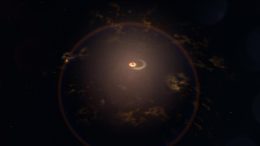
Illustration of a monster black hole siphoning gas off of an orbiting giant star. [NASA’s Goddard SFC/Chris Smith (USRA/GESTAR)]
The next talk of the press conference was given by graduate student (and Astrobites author!) Gourav Khullar from the University of Chicago. He discussed COOL J1241+2219, the brightest galaxy observed from when the universe was < 1.2 billion years old. This galaxy is unique because it is near the epoch of reionization. The team found that this galaxy was consistent with a constantly star-forming galaxy and that it has formed a few times the number of stars of the Milky Way in just 1/10th the time, and at a much earlier time in the universe!
Next was Bradford Snios from the Center for Astrophysics | Harvard & Smithsonian who discussed the discovery of a new quasar. The team focuses on quasar formation in the early universe; quasars are formed when black holes consume large quantities of matter for a long period of time. Because this process is so violent, most quasars are thought to be obscured by dust. It’s perhaps surprising, therefore, that we’ve found only a handful of obscured quasars at large distances! By using Chandra, the team uncovered the fourth obscured quasar ever discovered (which is at z = 4.56, or 10% the age of the universe), and it is 10–1000x brighter than other quasars discovered in the early universe!The final talk of the press conference was given by Feige Wang from the University of Arizona, who talked about an exciting new discovery. The team announced the detection of the most distant quasar ever discovered, which is seen just 670 million years after the Big Bang and is powered by a black hole that is 1.6 billion times the mass of our Sun! Press release
Recording of the live press conference
Live-tweeting of this session by Haley Wahl
NASA Town Hall (by Mike Foley)
Today’s town hall featured a lot of exciting updates about planned missions and budgetary considerations. First up was Dr. Thomas Zurbuchen (Associate Administrator for the Science Mission Directorate at NASA), who stressed the importance of open communication between NASA and astronomers. “Science is important for all!” he said, emphasizing the necessity of connection with non-scientists as astronomers seek to publicize their work. 2021 will have many long-awaited launches and projects from NASA, and the public deserves to know about all of this cool science.
Overall, the NASA Science Mission Directorate has a few key areas of focus for this year:
- Promoting open science through data sharing, open-source software, and other initiatives.
- Diversity and inclusion initiatives to “build the best teams we can.” Inclusion is now one of NASA’s criteria for evaluating mission success.
- Assessing and mitigating COVID-19 impacts on NASA research and missions.
In addition to these areas of focus, NASA also has a large number of projects planned for 2021. Below is a breakdown of 2021 milestones for the NASA science directorates. Some major highlights include the release of the Decadal Survey in the spring, which presents an overview of the state of astronomy and astrophysics in the United States. The telescope formerly known as WFIRST was renamed the Nancy Grace Roman Space Telescope in honor of NASA’s first chief astronomer and is well into development, with a completion date scheduled for the end of 2021. The James Webb Space Telescope (JWST) will also launch later this year, revolutionizing many areas of astronomy. Finally, the Mars Perseverance rover will land on February 18th, 2021!
In terms of research, NASA has started to implement dual-anonymous peer review. Because of this, the proportion of accepted proposals with female-identifying PIs (principal investigators) is now consistent with the full application pool! There is overwhelming agreement that the dual-anonymous peer review process improved the overall quality of the peer review. Astronomy research will also benefit from a significant funding package from Congress, allocating over $500 million more than was requested and featuring significant funds for JWST, Roman, Hubble, and SOFIA.
Live-tweeting of the session by Mia de los Reyes
HEAD Bruno Rossi Prize: Black Hole Imaging: First Results and Future Vision (by Mike Foley)

The first detailed image of a black hole, M87, taken with the Event Horizon Telescope. [Adapted from EHT collaboration et al 2019]
Since then, simulations have improved significantly, and the EHT relied extensively on large samples of simulations of black hole accretion disks to understand their results. These accretion disks are enormous — the one observed around the black hole in M87 is large enough to fit our entire solar system, even beyond the distance traveled by Voyager 1! Nevertheless, M87’s accretion disk is extremely faint when observed from Earth, and it requires incredible resolving power to see. To observe it, the EHT needed to make use of a network of telescopes all across the globe. They combined them to make one “super telescope” with an effective diameter the size of the Earth.

Eight stations of the EHT 2017 campaign over six geographic locations. [EHT Collaboration et al 2019]
Where to go from here? More resolution! The next generation EHT (ngEHT) will add new telescopes, improve hardware, and observe at two different wavelengths. Such improvements will yield a 3–10x increase in effective resolution, allowing for observations of up to 10 more sources and even potentially enabling scientists to create movies of a black hole! According to Dr. Doeleman, “ngEHT development is underway, with the promise of a black hole cinema by the end of this decade.” Such groundbreaking results will continue to revolutionize our understanding of supermassive black holes and help define the next era of astronomy.
Interview of Sheperd Doeleman by Gloria Fonseca Alvarez
Live-tweeting of the session by Mike Foley
Special Session: Collaboration with Integrity: Partnerships with Indigenous Communities in the Americas and Polynesia (by Luna Zagorac)
Now at #AAS237: Session 225 – Collaboration with Integrity: Partnerships with Indigenous Communities in the Americas and Polynesia.
— astrobites (@astrobites) January 12, 2021
This session was chaired by Prof. Aparna Venkatesan (University of San Francisco), who began it with a land acknowledgement for where the meeting would have been held: on the land of the Tohono O’odham Nation in Phoenix, Arizona. Prof Venkatesan further acknowledged the difficulty of the past year and the inequality that exists is society and astronomy, asking: “Can we choose a collaborative approach, rather than a transactional approach?… In gaining the stars, who are we losing?”
Afterwards, Prof. Venkatesan introduced Professor Nancy Maryboy and Professor David Begay of the Indigenous Education Institute and Northern Arizona University who spoke about Diné-Navajo astronomical knowledge. Prof. Maryboy noted that “the Diné-Navajo word for Star, Sitsoii Yoo, refers to my ancient relation from where I came…When we look at the Milky Way Galaxy at night we are actually looking at ourselves.” Prof. Begay underlined that the key words here are “ancient” and “relation,” reminding us that we are all made up of the elements of the cosmos. Prof. Begay went on to explain the connection of the hogan, the Navajo house, and the cosmos that is home to us all, noting that this is why there is no word meaning “homeless” in the Navajo language. Prof. Maryboy spoke more about heliophysics and relationships to the Sun — called Johannaa’ éí, and depicted as a man on a horse carrying the solar disk. She also spoke of the Navajo hero twins that visit the Sun, comparing them to the NASA Solar Orbiter and Solar Probe. The Navajo have a long history of discussing travelling to the Sun, she noted.
The next speaker was Dr. Kaʻiu Kimura, Executive Director of the ‘Imiloa Astronomy Center of Hawaiʻi at the University of Hawaiʻi – Hilo. Dr. Kimura has spoken at previous AAS meetings about A Hua He Inoa, an initiative to use ʻōlelo Hawaiʻi (the Hawaiian language) in naming conventions for naming astronomical objects. Celestial nomenclature and acknowledging connections with the sky has been a part of the Hawaiian universe since the very start (see A Catalogue of Hawaiian and Pacific Star Names), and Dr. Kimura noted that “through naming, we connect to events of historical experience…Names tell stories.” Some recent examples of of using ʻōlelo Hawaiʻi include: asteroid Kamoʻoalewa, alluding to a celestial object that is oscillating, like its path in the sky as viewed from the Earth; black hole Pōwehi, an “embellished source of unending creation,” referring to the recently-imaged black hole at the center of M87; and quasar Pōniuāʻena. Kimura also shared a video of one of the 30 kumu (teachers) from Hawaiian immersion schools, who spoke about the naming as the result of relaying modern technology with 1,621-year history of Indigenous Hawaiian intelligence. Dr. Kimura also emphasized the importance of building connection and developing meaningful relationships between communities, noting that true collaboration is authentic and embraces everyone.
Finally, for the panel part of the session Prof. Venkatesan introduced the remaining panelists: Dr. Douglas Simons of the Canada-France-Hawaii Telescope, Dr. Isabel Hawkins of Exploratorium, and Dr. Laura Peticolas of Sonoma State University. While we did not cover this part of the session in detail, we will end our write-up with a note from Dr. Hawkins that was echoed by Dr. Kimura: introducing Hawaiian naming conventions goes both ways, and Western-trained astronomers can benefit greatly from learning about the language and Indigenous astronomical knowledge more generally.
Press Conference: Sloan: The Energizer Bunny of Sky Surveys (by Haley Wahl)
The Sloan Digital Sky Survey has been mapping out the universe for more than two decades now, and it’s still going strong! Today’s second press conference focused on some of the latest results to come out of the survey.
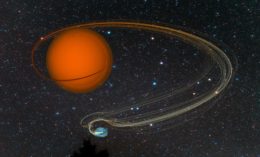
An artistic impression based on a computer simulation of the Draco C1 symbiotic binary star system showing material flowing off the red giant star onto the white dwarf. [John Blondin, North Carolina State University]
The second speaker was Dr. Allyson Sheffield from LaGuardia Community College, who discussed new discoveries in the Jhelum stellar stream. Her team examined this stream of stars and found the brightest known member. They also were able to deduce that the Jhelum stream stars may have originated in a satellite galaxy or a globular cluster, and found that stars from the Gaia-Enceladus-Sausage merger do not appear to be associated with the Jhelum stellar stream. Press release
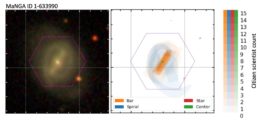
Left: optical image of a galaxy shown to citizen scientists. Right: the heat map of the galaxy’s internal structures collectively generated by the citizen scientists’ input. [Karen Masters (Haverford College), Coleman Krawczyk (University of Portsmouth), and the SDSS Collaboration]
The final talk of the press conference, “A Handoff from SDSS IV to SDSS V,” was given by Juna Kollmeier of Carnegie Observatories and Michael Blanton of New York University. SDSS IV is currently finishing its observations after its 6-year survey, and over the last 20 years, SDSS has made the largest 3D map of the universe, looked at over 10,000 nearby galaxies with MaNGA, and more! SDSS-V plates are currently being constructed using robots that place fibers, which will dramatically increase efficiency in the next phase of the survey. A few components of SDSS-V include: the Milky Way Mapper (which will measure stars in all stellar populations and across the galaxy), the Local Volume Mapper (which will study how stars form and exchange energy with interstellar gas), and the Black Hole Mapper (which will trace how black holes evolve on short and long timescales)!
Recording of the live press conference
Plenary: Cosmology in the Era of Multi-Messenger Astronomy (by Tarini Konchady)
The last plenary talk of the day was given by Dr. Marcelle Soares-Santos (University of Michigan), who tackled how cosmology is changing as gravitational wave observatories come into their own. Soares-Santos is deeply involved in the Dark Energy Survey (DES), which aims to study dark energy and large scale structure to better understand the universe.
What’s the benefit to introducing gravitational wave science into cosmology? Over the past few decades, astronomers have been increasingly stymied by measurements of the Hubble constant — the rate at which the universe is expanding. Measurements of the Hubble constant from the cosmic microwave background differ significantly from those measurements made using redshifts and distances as determined by Type Ia supernovae. This is strange, because our models of the universe predict that the Hubble constant should have the same value no matter how you measure it!
Soares-Santos said gravitational wave events could provide a tiebreaker between these two measured values of the Hubble constant. The changing frequency of gravitational wave signals can give you the distance to the event, and the electromagnetic counterpart of the event would give you its redshift, allowing an independent measurement of the Hubble constant.

The Hubble constant as estimated by the event GW170817 is shown by the blue curve. The dashed lines are confidence intervals on this estimate. The green region is the Hubble constant measurement made from the cosmic microwave background and the orange region is the measurement made from the distances and redshifts of Type Ia supernovae. [The LIGO Scientific Collaboration and The Virgo Collaboration, et al. 2017]
With the electromagnetic signal of a neutron star merger in hand, Soares-Santos was able to demonstrate that combining DES data with less than ten neutron star mergers could significantly cut down on uncertainty in cosmological parameters. However, binary black hole mergers — the most common gravitational wave event so far — require a different approach.
There currently aren’t any known electromagnetic counterparts to black hole mergers. But if you know roughly where a merger took place and map out all the galaxies in that region, you can generate the probability that the merger took place in a particular galaxy. From there, you can determine the galaxy’s redshift and pair it with the distance as measured from the merger signal.
The more merging events we can detect, the better we can constrain the Hubble Constant, and therefore the age of the universe. According to this figure, we should have a well constrained value by *2023.* pic.twitter.com/B0o7NpYnTm
— astrobites (@astrobites) January 12, 2021
Soares-Santos closed by noting that this particular area of astronomy is changing at a breakneck pace (and would make a great entry point for new grad students!). More optical surveys are coming online in the next few years along with a larger gravitational wave observatory network. It’s feasible that by the late 2020s, we’ll have a high precision measurement of the Hubble constant just based on gravitational wave events!
Interview of Marcelle Soares-Santos by Gloria Fonseca Alvarez
Live-tweeting of the session by Abby Waggoner

